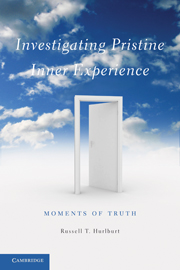Book contents
- Frontmatter
- Contents
- List of Figures and Tables
- Preface
- Acknowledgments
- 1 Moments of Truth
- 2 Fragmented Experience in Bulimia Nervosa
- 3 Apprehending Pristine Experience
- 4 Everyday Experience
- 5 Moments Are Essential
- 6 Experience in Tourette's Syndrome
- 7 The Moment (Not): Happy and Sad
- 8 Subjunctification
- 9 Before and After Experience? Adolescence and Old Age
- 10 Iteration Is Essential
- 11 Epistemological Q/A
- 12 A Consciousness Scientist as DES Subject
- 13 Pristine Experience (Not): Emotion and Schizophrenia
- 14 Multiple Autonomous Experience in a Virtuoso Musician
- 15 Unsymbolized Thinking
- 16 Sensory Awareness
- 17 The Radical Non-subjectivity of Pristine Experience
- 18 Diamonds versus Glass
- 19 Into the Floor: A Right-or-Wrong-Answer Natural Experiment
- 20 The Emergence of Salient Characteristics
- 21 Investigating Pristine Inner Experience
- Appendix: List of Constraints
- References
- Index
14 - Multiple Autonomous Experience in a Virtuoso Musician
Published online by Cambridge University Press: 05 June 2012
- Frontmatter
- Contents
- List of Figures and Tables
- Preface
- Acknowledgments
- 1 Moments of Truth
- 2 Fragmented Experience in Bulimia Nervosa
- 3 Apprehending Pristine Experience
- 4 Everyday Experience
- 5 Moments Are Essential
- 6 Experience in Tourette's Syndrome
- 7 The Moment (Not): Happy and Sad
- 8 Subjunctification
- 9 Before and After Experience? Adolescence and Old Age
- 10 Iteration Is Essential
- 11 Epistemological Q/A
- 12 A Consciousness Scientist as DES Subject
- 13 Pristine Experience (Not): Emotion and Schizophrenia
- 14 Multiple Autonomous Experience in a Virtuoso Musician
- 15 Unsymbolized Thinking
- 16 Sensory Awareness
- 17 The Radical Non-subjectivity of Pristine Experience
- 18 Diamonds versus Glass
- 19 Into the Floor: A Right-or-Wrong-Answer Natural Experiment
- 20 The Emergence of Salient Characteristics
- 21 Investigating Pristine Inner Experience
- Appendix: List of Constraints
- References
- Index
Summary
Have you ever sat in a concert and wondered what was going on with the performer, what it was like to be a virtuoso performer? In this chapter we'll ask a virtuoso to take a DES beeper on stage during a performance and give us a glimpse.
Colombia-born classical guitar virtuoso Ricardo Cobo gave his professional debut with the Orquesta Filarmonica de Bogota at age sixteen for a nationwide telecast audience of over nine million. He later won the prestigious Guitar Foundation of America International Guitar Competition and has gone on to a successful recording and performing career.
Cobo is one of the foremost students of master guitar teacher Aaron Shearer. Shearer was the author of one of the most successful guitar methods of all time, and was creator and a tireless promoter of a method of visualization he called “aim directed movement” or ADM, which Anderson (1980) described as follows:
Visualization requires that before a note (or note group) is played, the guitarist can see, in his mind's eye, which string and fret the note(s) will be played on, and which fingers of the left and right hands will play the note(s). Once the guitarist has cultivated the ability to perceive these images on the guitar, then he is at least on his way to practicing accurately.
(Anderson, 1980, p. 10)- Type
- Chapter
- Information
- Investigating Pristine Inner ExperienceMoments of Truth, pp. 258 - 290Publisher: Cambridge University PressPrint publication year: 2011



